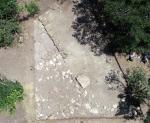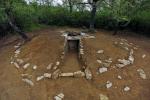Summary (English)
The discoveries made in 2018 revealed new archaeological evidence of the Etruscan settlement. The investigations concentrated on the saddle separating the hilltop of Poggio all’Olivo from that of San Germano, at c. 200 m “as the crow flies” from the acropolis. The excavation area covered c. 80 m2, divided into two trenches A and B. In the first, a few centimetres below the ground surface, part of an area paved with slabs of galestro stone came to light. It was bordered by parapets made of the same material. The area, with the due reserve at this early stage, may be interpreted as an impluvium, suggested by the particular construction of the south parapet, which only had finished stones on the side facing towards the paved area. The stretch of wall that emerged in trench B was on a similar alignment and probably part of the same complex.
The most data came from the northern part of trench A where a layer made up of pottery and tile fragments was identified south of another wall on the same alignment as the others but in a different construction technique that used larger stones.
The building with the paved area may have been abandoned between the 1st century B.C. and the 1st century A.D. as seems to be suggested by several fragments of black glaze and Italian sigillata pottery. Few remains of this structure survive in trench A, while the northern part of trench b, is higher and flat therefore less subject to slope erosion and could be better-preserved. This structure was probably built using the remains of one or more earlier buildings. Of these, only a stretch of wall and, what seems to be part of a roof collapse, are visible at present. A cut, partially excavated, south of the paved area may relate to this phase. At the interface of the fill, there was the base of a black glaze bowl with stamps and wheel decoration, placed upside down in isolation. The finds recovered thus far suggest the occupation could date to the earlier part of the 3rd century B.C. At the moment, the only evidence, apart from the cut, is a large mortarium made of trachyte stone that was found at the trench edge, inserted into a cut made in the geological stratum and wedged with several tile fragments which, at this level suggests it was the occupation level preceding the abandonment phase. Generally, the function of this southern sector, where no layers relating to the latest phase are preserved due to the shallow covering of earth, will only be clarified by the continuation of excavations, which will aim to verify the presence of other traces or cuts in the natural geology.
- Luca Cappuccini - Dipartimento SAGAS – Università degli Studi di Firenze
Director
Team
- Giuditta Pesenti - Università di Firenze
- Giuditta Pesenti - Università di Firenze
Research Body
- Dipartimento Sagas – Università di Firenze
Funding Body
- Azienda “Rocca di Frassinello” (Gavorrano, GR)






![Download [PDF]](/excavation/skins/fasti/images/results/download_sml.png)
